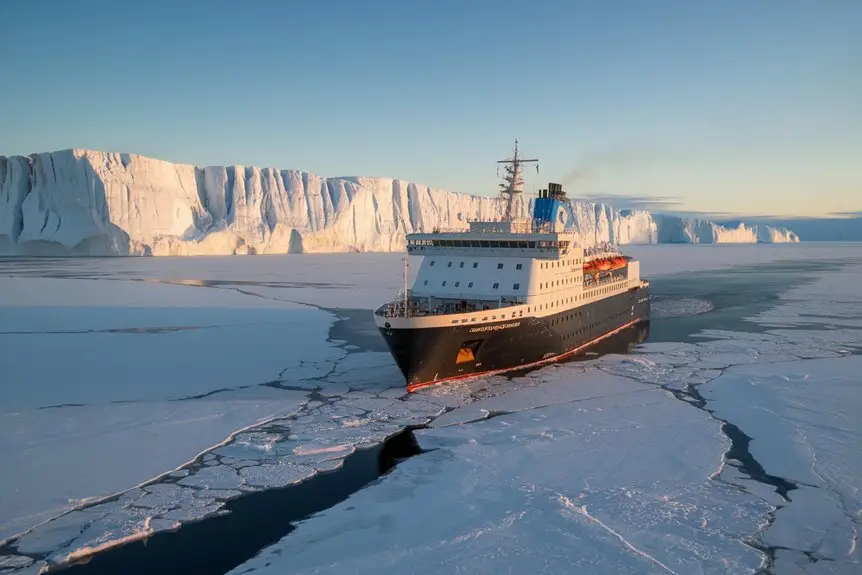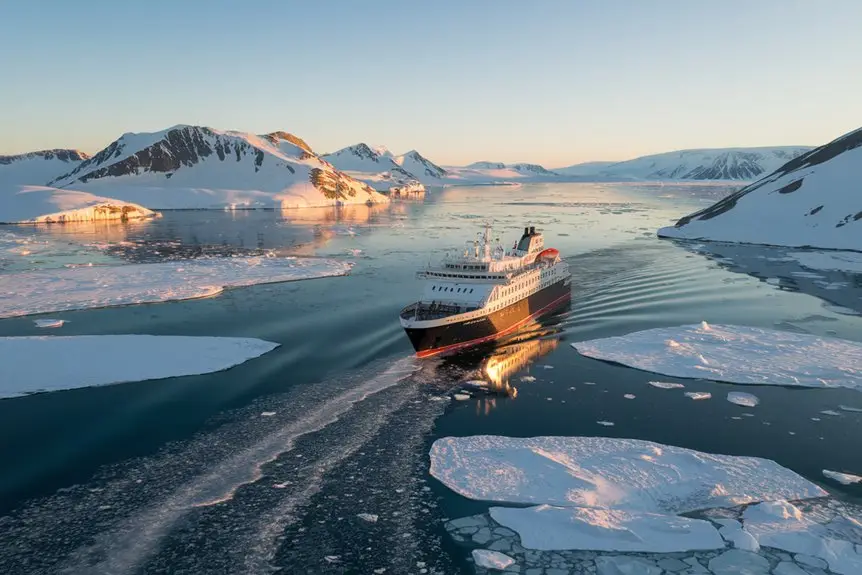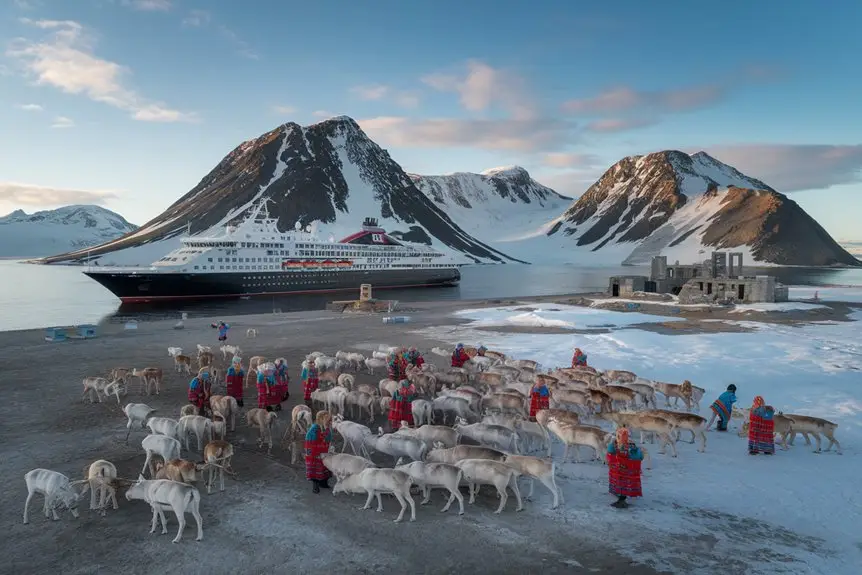Severnaya Zemlya welcomes cruise visitors during July and August when the Arctic ice conditions are best. You must obtain your permits from the Northern Sea Route Administration before your journey. You can spot polar bears and walrus colonies from your ship’s deck. You’ll see many seabirds, including ivory gulls, during Zodiac boat tours.
For other Russia Cruise destinations check out our Russia Cruise Ship Ports Guide page.
The islands carry Soviet-era names like October Revolution and Bolshevik. Each island offers unique wildlife viewing and photographic opportunities. You should pack warm, weatherproof clothing for the changeable Arctic climate. Your camera will capture the stark beauty of this remote Russian frontier.
The archipelago’s isolated location means you’ll explore areas few travellers have seen. Your cruise ship provides a comfortable base for discovering these Arctic islands. You can join guided excursions to learn about the region’s natural history and Soviet heritage.
🐧 Polar Cruise Enquiry 🐻❄️
Our team of polar travel specialists have personally explored both the Arctic and Antarctic regions – from tracking polar bears in Svalbard to kayaking with penguins off the Antarctic Peninsula. Let us find the right polar expedition cruise for you.
Navigating the Russian Arctic Waters

Navigating Russian Arctic waters needs specific preparations and safety measures. You’ll need permission from the Northern Sea Route Administration before starting your journey.
Your main challenges include:
- Large ice formations (massifs) that move with winds and currents
- Limited GPS and navigation system coverage
- Changing routes based on ice conditions
Your essential requirements:
- A valid Polar Ship Certificate
- Crew with Arctic navigation training
- Russian icebreaker escort services
- Both electronic and paper navigation charts
Your navigation tools must include:
- GPS and GLONASS systems (magnetic compasses won’t work reliably)
- VHF radio tuned to channel 16 for icebreaker communications
Your route will change regularly based on:
- Current ice thickness
- Weather conditions
- Icebreaker availability
Keep your navigation equipment updated and maintain constant communication with your escort vessels. Your safety depends on following these protocols and staying alert to changing Arctic conditions.
Best Times to Visit

Best times for your Russian cruise depend on your chosen destinations and activities.
You can visit the Arctic region of Severnaya Zemlya most successfully in July and August. The ice conditions become manageable, and you’ll get more daylight hours to watch wildlife like polar bears and walruses.
Winter offers you special icebreaker voyages, though weather conditions become more difficult.
You might want to plan a broader Russian journey in summer when you can experience St Petersburg’s White Nights and visit the Golden Ring cities easily.
Remember that summer brings peak season prices and busier ports, so you’ll need to book well ahead.
Your comfort level with different weather conditions should guide your timing choice.
Wildlife Watching Experiences

You’ll discover amazing wildlife throughout your cruise, with each day bringing new sightings.
Polar bears often swim between ice floes or hunt seals right before your eyes. Your Zodiac trips take you close to walrus colonies lounging on the shoreline, whilst seals pop up in the waters around you.
The islands burst with birdlife, especially on Domashnyy Island where ivory gulls nest in large numbers.
You can spot little auks at their breeding grounds, whilst black-legged kittiwakes, guillemots and glaucous gulls soar above you.
Your land excursions offer chances to see Arctic foxes, wolves and reindeer crossing the tundra.
Keep your camera ready for snow buntings and purple sandpipers darting about the landscape.
Onshore Expedition Planning

Planning Your Onshore Expedition
You need to prepare your expedition carefully across spring and summer seasons. First, contact the Russian authorities for your permits and arrange access through designated airfields or ice bases like Cape Baranova.
Your team must include:
- Arctic guides
- Support staff
- Safety specialists
Your transport options cover:
- Toros vehicles for ground movement
- Helicopters for equipment transfer
You should:
- Follow established expedition routes
- Monitor weather updates daily
- Keep radio contact with your base
- Minimise your environmental impact
- Document your route plans
The Arctic ecosystem requires your careful attention.
You’ll travel through sensitive areas, so stick to marked paths and follow local guidance. Your base station needs your regular position updates, and you must check weather forecasts before each day’s journey.
Your equipment needs thorough testing before departure.
Pack backup communications gear and ensure your team knows how to use all safety equipment. Keep your plans flexible – Arctic conditions can change quickly.
See what’s on offer from the Novaya Zemlya Cruise Ship Ports Guide for a different Russia Cruise destination.
Cultural and Historical Highlights

The cultural story of Severnaya Zemlya begins with its naming in 1913.
You’ll find that Czar Nicholas II gave the archipelago its first name, which Soviet authorities changed in 1926 to its current name.
You can visit Domashnyy Island, where explorer G.A. Ushakov led the first detailed mapping project from 1930 to 1932.
A memorial headstone marks this historic expedition’s achievements.
The archipelago’s main islands carry Soviet-era names: October Revolution, Bolshevik, Komsomolets and Pioneer.
These names reflect the political changes Russia experienced in the 20th century.
Today, you’ll notice an ongoing discussion about the islands’ identity.
Orthodox Church groups want to restore the original imperial name, while others prefer to keep the current one.
This debate shows how Russia views its Arctic heritage and traditional values.
Frequently Asked Questions
What Emergency Medical Facilities Are Available on the Archipelago?
Emergency medical care on the archipelago consists of basic ambulance services and military medical facilities. You can access these services near military bases and research stations. Medical staff includes feldshers (medical practitioners), nurses, and a small team of doctors. The emergency response system operates 24/7, but with limited resources compared to mainland facilities. You should note that specialist medical care may require transport to larger medical centres off the archipelago.
Are Satellite Phones and Internet Connections Reliable During the Cruise?
Satellite phones and internet connections work best when you’re on the open decks of your cruise ship. You can get reliable signals through Iridium’s network when you have a clear view of the sky. The ship’s metal structures and indoor locations might weaken your connection, so step outside for the best results. For the most reliable service, choose spots away from overhead obstacles.
What Photography Equipment Restrictions Exist When Visiting Russian Arctic Military Zones?
Photography restrictions in Russian Arctic military zones are straightforward. You cannot use drones, infrared cameras or night vision devices. You need special permits for high-resolution cameras when visiting areas near military installations. Keep your standard tourist camera equipment simple to avoid complications. Check current regulations before your visit, as rules can change.
Can Passengers Collect Geological Specimens or Plant Samples During Shore Excursions?
Collecting geological specimens and plant samples is not allowed on shore excursions. You must leave all natural materials, including rocks, plants and soil, in their original location. Arctic regions have strict environmental protection rules that you need to follow. These guidelines help preserve the delicate Arctic ecosystem for future generations. Your tour guides will explain the specific rules for each landing site you visit.
What Insurance Requirements Are Specific to Russian Arctic Expedition Cruises?
You need specific insurance coverage for Russian Arctic expedition cruises:
Your policy must:
- Cover at least £150,000 for emergency evacuation and medical expenses
- Explicitly state coverage for Russian Arctic regions
- Include high-risk adventure activities
- Be valid for the entire duration of your expedition
Check that your insurance provider recognises Arctic expeditions as a covered activity. Many standard travel policies don’t include polar regions or extreme environments.
Thinking about something different? Check out the cruises leaving from Bear Islands Cruise Ship Ports Guide.
🐧 Polar Cruise Enquiry 🐻❄️
Our team of polar travel specialists have personally explored both the Arctic and Antarctic regions – from tracking polar bears in Svalbard to kayaking with penguins off the Antarctic Peninsula. Let us find the right polar expedition cruise for you.
